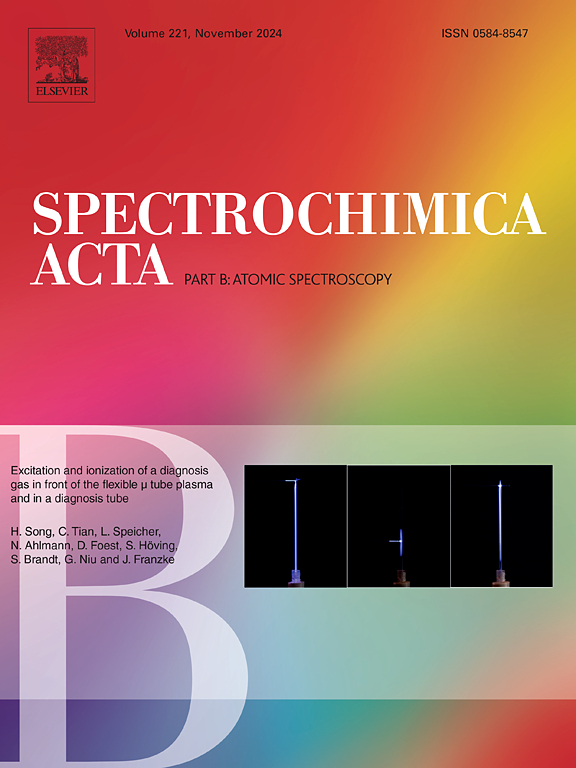用激光吸收光谱法表征铀激光等离子体的电子密度和电离
IF 3.2
2区 化学
Q1 SPECTROSCOPY
引用次数: 0
摘要
高分辨率可调谐激光光谱用于测量激光等离子体中10个中性铀跃迁和6个单电离跃迁的时间分辨吸收光谱。分析谱线形状以确定离子和中性总柱密度、激发温度、动力学温度和等离子体冷却时的碰撞展宽效应的时间变化。离子柱密度与中性柱密度的比较表明,等离子体发生后15 μs,离子柱密度与中性柱密度之比大于10,直到50 μs才趋于一致。通过分析谱线形状来区分Stark和van der Waals对碰撞展宽的贡献,从而确定电子密度从4-25 μs随时间从~ 1015-1013 cm−3下降。使用吸收光谱学来确定这些时间尺度和低量级的电荷特性和电子密度,为传统发射光谱学无法获得的等离子体特性提供了有价值的见解。离子和中性密度、激发温度、动力学温度和电子密度之间的比较可以表明与局部热力学平衡和萨哈电离预测的潜在偏差。本文章由计算机程序翻译,如有差异,请以英文原文为准。

Characterization of electron density and ionization of a uranium laser produced plasma using laser absorption spectroscopy
High-resolution tunable laser spectroscopy is used to measure time-resolved absorption spectra for ten neutral uranium transitions and six singly-ionized transitions in a laser produced plasma. Spectral lineshapes are analyzed to determine temporal variations in ion and neutral total column densities, excitation temperatures, kinetic temperatures, and collisional broadening effects as the plasma cools. Comparison of ion to neutral column densities shows a ratio greater than 10 at times 15 μs after plasma onset, with the ratio not reaching unity until 50 μs. Spectral lineshapes are analyzed to separate Stark and van der Waals contributions to collisional broadening, from which electron densities are determined and found to decrease from 1015–1013 cm−3 over times from 4–25 μs. Using absorption spectroscopy to determine charge properties and electron density over these time scales and at low magnitudes provides valuable insight into plasma properties not obtainable using conventional emission spectroscopy. Comparisons between ion and neutral densities, excitation temperatures, kinetic temperatures, and electron densities could indicate potential deviations from local thermodynamic equilibrium and Saha ionization predictions.
求助全文
通过发布文献求助,成功后即可免费获取论文全文。
去求助
来源期刊
CiteScore
6.10
自引率
12.10%
发文量
173
审稿时长
81 days
期刊介绍:
Spectrochimica Acta Part B: Atomic Spectroscopy, is intended for the rapid publication of both original work and reviews in the following fields:
Atomic Emission (AES), Atomic Absorption (AAS) and Atomic Fluorescence (AFS) spectroscopy;
Mass Spectrometry (MS) for inorganic analysis covering Spark Source (SS-MS), Inductively Coupled Plasma (ICP-MS), Glow Discharge (GD-MS), and Secondary Ion Mass Spectrometry (SIMS).
Laser induced atomic spectroscopy for inorganic analysis, including non-linear optical laser spectroscopy, covering Laser Enhanced Ionization (LEI), Laser Induced Fluorescence (LIF), Resonance Ionization Spectroscopy (RIS) and Resonance Ionization Mass Spectrometry (RIMS); Laser Induced Breakdown Spectroscopy (LIBS); Cavity Ringdown Spectroscopy (CRDS), Laser Ablation Inductively Coupled Plasma Atomic Emission Spectroscopy (LA-ICP-AES) and Laser Ablation Inductively Coupled Plasma Mass Spectrometry (LA-ICP-MS).
X-ray spectrometry, X-ray Optics and Microanalysis, including X-ray fluorescence spectrometry (XRF) and related techniques, in particular Total-reflection X-ray Fluorescence Spectrometry (TXRF), and Synchrotron Radiation-excited Total reflection XRF (SR-TXRF).
Manuscripts dealing with (i) fundamentals, (ii) methodology development, (iii)instrumentation, and (iv) applications, can be submitted for publication.

 求助内容:
求助内容: 应助结果提醒方式:
应助结果提醒方式:


